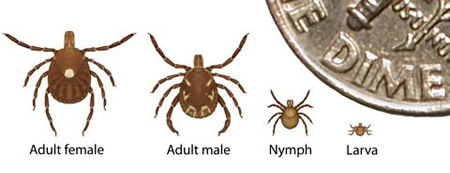Southold forming committee to combat deer ticks

Find an area with a deer problem, and you’ll probably also find a tick problem. That holds especially true for the North Fork.
But how can Southold Town deal with tick-borne illnesses when managing the deer population has proven to be difficult and complicated?
Finding that answer is the goal of a new exploratory town tick committee now in the works.
This week, town officials started efforts to recruit qualified individuals for the committee, said Supervisor Scott Russell.
“What we’re proposing is almost like a working group,” he said. “We’re asking the committee to evaluate anything that has been implemented with regard to tick control.”
Suffolk County has its own countywide Tick Control Advisory Committee, but now Southold officials are hoping to form a more localized group.
In particular, Southold is so narrow and dense that it is difficult to meet certain tick-management regulations.
Mr. Russell said he recognizes “frustration” over the town’s previous attempts to control the local deer population — especially last year’s controversial deer cull.
“The more deer you have, the more ticks you have and the more tick-borne illness,” he said. “But obviously, since the deer issue is going to take some time … tick management is something we can start focusing on right away.”
Five to seven volunteers will comprise the anti-tick team, and the town wants individuals with specific qualifications, including a wildlife biologist and a public health expert.Members of the tick committee would serve on a set four-month timeframe, Mr. Russell said.
Mr. Russell hopes to have the team up and running in four to six weeks. The town would only pay for travel reimbursement for the committee members.
John Rasweiler, a Cutchogue resident and member of Suffolk County’s tick committee, said the area’s tick population is a major concern that must be addressed.
“I would call it a full-fledged public health crisis or emergency,” he said.
Blacklegged and lone-star ticks, which live on the bodies of the North Fork’s deer, can carry Lyme disease, babesiosis, anaplasmosis and other illnesses, according to the Centers for Disease Control.
These ticks are particularly dangerous because they are most likely to transmit disease in their nymph stage — just before they become adults. A ticks nymph can be as small as a poppy seed, according to the CDC’s website.
Mr. Rasweiler described several large-scale methods for addressing the tick explosion on the East End, including deer culls through hunting, spraying a tick-killing pesticide called permethrin and the “4-poster system” now being used on Shelter Island.
That system uses bins of corn to attract deer. While the deer feed, their necks and ears rub against paint rollers doused with permethrin, killing any ticks that may be attached.
Mr. Rasweiler, however, was unconvinced that 4-poster devices are the solution to Southold’s tick problems.
“These are very clever devices, and a number of years ago, I was one of the people that advocated for us to use them,” he said. “But then I began to educate myself on them, and there are a number of seriously problems with them.”
For one, each device can cost about $5,000 per year, he said. And since the devices attract so many deer, Mr. Rasweiler said the vegetation in the area could be completely stripped by grazing animals.
Mr. Russell said the committee would be careful to consider potential costs of any potential tick-management system, including 4-poster devices like those on Shelter Island.
“What would it cost to implement a similar project throughout Southold town?” he said. “We need to evaluate every option not just on effectiveness, but also on whether we can afford it.”
But Mr. Rasweiler stressed that any efforts to lower tick infestation must go hand-in-hand with plan to deal with the deer population.
“Unless you treat 90 percent of the deer, you’re probably wasting your time and money,” he said.








